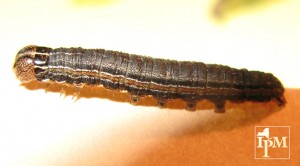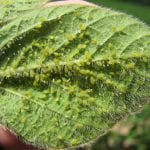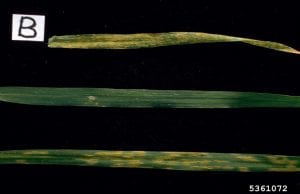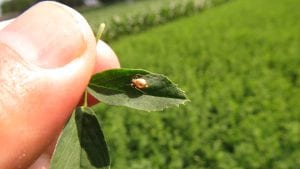Contents
Farmer Tick Survey, 2018 – From the NYSIPM Program
The Community IPM Program (part of NYSIPM) was funded by the NY State Senate Task Force on Lyme and Tick Borne Disease to create an educational campaign about the risks of tick exposure and tick awareness for New York. Community IPM addresses non-agricultural pest issues for every New York resident, including farmers. This survey is a research project to help us understand what tick issues and concerns NY farmers are facing on their farms and home properties. By completing this survey, you are agreeing to participate in this research. Your answers are completely anonymous and will help us understand how serious the issue is and how to raise awareness with the farming community.
For more information about this survey or about ticks and tick prevention or control, please contact Jody Gangloff-Kaufmann at jlg23@cornell.edu .
Please fill out the survey (just 10 questions!) here:
View from the Field
True Armyworm (Pseudaletia unipuncta)
Mike Hunter (CCE Northern NY) is finding a lot of true armyworm in grass hay fields in Northern NY. He states the larvae are still very small (1 mm to 1.5 mm) and are in the 1st instar. These armyworm moths most likely have come on the recent storms from the south and laid their eggs in hay fields. If there is a lot in the field, you will not see much damage until they reach the later instars. True armyworm larvae in their (6th) final instar will eat 80% of all the forage they will consume. Many times a hay field can look great in the evening and gone the next day if they all reach the 6th instar about the same time.
It is best to scout your fields ASAP and look for smaller larvae. Be proactive make sure you know if your fields are infested. True armyworm will feed on grasses, corn and small grains. There are economic thresholds for corn and small grains.
Recommended economic thresholds for corn:
- seedling: 10 percent or more plants show damage and larvae are still present.
- whorl-stage: apply an insecticide when there are three or more larvae per plant.
- Tall corn seldom needs treatment unless the leaves above the ear are also damaged.
Recommended economic thresholds for small grains:
- Wheat/small grains – 5 or more larvae per linear ft of row, larvae less than 1.25 inches and not parasitized, watch for flag leaf reduction or if grain heads clipped off – yield losses, a spray before soft dough to save the remaining 3 upper leaves is generally beneficial since these tissues are still important to grain filling
Recommended economic thresholds for grasses:
- Grasses – no specific guidelines available, need for treatment based on the level of damage observed in relation to the expected value of grass harvest
Most years, natural enemies—various fungal and viral diseases as well as parasites such as tachinid flies—help suppress armyworms. You cannot be sure when and where they occur.
Sometimes when armyworms are at very high populations, they will march to new fields. They can be in a hay field and move to a corn or small grains field.
SPECIAL NOTE: if you spray for armyworm the CROP and True/Common Armyworm has to be on the label! READ THE LABEL!!!!!
Check the Cornell Guide for Integrated Crop Management for an insecticide labeled for use.
I have added some web links that have specific armyworm information:
Armyworm (Pseudaletia unipuncta Haworth)
Armyworm as a Pest of Field Corn
Cornell Guide for Integrated Field Crop Management
Armyworm Damage to Field Corn and Grass Hay and Pasture
Soybean Aphid (Aphis glycines)
There are reports of soybean aphids in soybeans in western and central NY. The population levels are very low. Watch population of aphids as soybeans start entering the reproductive stages of growth. Aphids can cause yield losses in reproductive stages of growth if they reach 250 aphids per plant or higher (R1-R5). We will publish more information on soybean aphids in future issues.
Crown rust (Puccinia coronata var. avenae)
Gary Bergstrom (Cornell Extension Field Crops Plant Pathologist) is reporting crown rust on oats in Western NY. Moderate to severe infections can reduce grain yield by 10 to 40%. Orange pustules develop on the leaves. They can also develop on the stem or leaf sheath. Soon after they develop they will bust sending spores into the air creating an orange dust. If not controlled in time the leaves will dry out and will not continue to photosynthesis; thus reducing yield.
Pea Aphid (Acyrthosiphon pisum)
There has been a lot of reports of high infestation of pea aphids. One of the reasons we do not have big problems with them is because of all the natural enemies. While scouting this week I came across a sight I see most years, an aphid mummy that had been parasitized by tiny Hymenopteran call a parasitoid. They lay their eggs on the inside of the aphid. Once the eggs hatch they eat the inside and leave just the exoskeleton.
Field Day Events
Cornell University Willsboro Research Farm Open House: Willsboro, NY – July 10, 2018
The Cornell University Willsboro Research Farm will hold an open house on Tuesday, July 10 from 1:30pm to 4:00pm. A tour of the facilities and research plots will leave the main office (48 Sayward Lane, Willsboro) at 2:00pm. Light refreshments will be provided. Research topics featured at this year’s open house include corn silage variety trials, adaptive nitrogen management for field corn, cover crops, juneberry nursery and production trials, Aronia variety plantings, honeyberry variety trial, high tunnel vegetable production, reduced tillage demonstration plots, season extension for early spring vegetables, organic pepper variety trial, and goldenberry and groundcherry variety evaluations. For more information call 518-963-7492.
2018 Aurora Farm Field Day: Thursday, July 12, 2018 at 9:30am to 3:30pm
Our annual Field Crops field day held at Musgrave Research Farm in Aurora, NY is set for July 12th. The field day is free and open to the public and includes a BBQ lunch.
Skip the registration line by PRE-REGISTERING!
DEC and CCA credits will be available. (DEC: Demonstration – 3.25, Agricultural Plant – 3.25, Field and Forage – 3.25, Vegetable – 1.25)
http://events.cornell.edu/event/2018_aurora_farm_field_day
Weather Outlook – July 5, 2018
Jessica Spaccio
NOAA Northeast Regional Climate Center, Cornell University
Last week temperatures ranged from 2-10 degrees above-normal. Precipitation has ranged from less than ¼ “ to over 3”. Base 50 growing degree-days ranged from 130-210. Abnormally dry conditions have been expanded for part of northern NY and the finger lake region.
Another hot day Thursday before a cold front brings storms and cooler weather.
Today temperatures will be in the mid 80s to mid 90s and muggy. Heat advisories will continue for some areas. A cold front will bring showers and thunderstorms, some possibly severe with heavy rain and flooding, mostly to central and western NY. Overnight lows will be in the mid 50s to mid 60s.
Friday will start rainy for some areas as another, stronger cold front moves through Thursday night into Friday morning, showers will diminish from west to east with cooler temperatures following. Highs will be in the 70s to low 80s. Overnight temperatures will be in the mid 40s to mid 50s. Saturday will be sunny with temperatures in the 70s to low 80s with lower humidity. Overnight temperatures will be in the upper 40s to upper 50s.
Sunday highs will be in the 70s to low 80s.
Overnight temperatures will be in the upper 40s to upper 50s. Monday temperatures will be in the mid 70s to 80s.
Overnight temperatures will be in the upper 40s to upper 50s with showers and thunderstorms possible into Tuesday. Tuesday will have temperatures in the upper 70s to 80s. Overnight temperatures will be in the 50s. Wednesday will be dry with highs in the 80s. Overnight temperatures will be in the 50s. The seven-day precipitation amounts will range from a trace to one inch. The 8-14 day outlook (July 12-18) favors above-normal temperatures for all of the state. The precipitation outlook slightly favors above-normal amounts for most of the state and favors near-normal precipitation for the northeast corner of the state.
National Weather Service watch/warnings map
Clipboard Checklist
Keith Waldron, NYS IPM
General
*Walk fields to check general field condition, weed issues
*Watch for crop maturity, stand assessments, weed escapes, nutrient deficiencies, lodging issues
Alfalfa:
*Evaluate established legume stands for approximate days until harvest
*Monitor potato leafhopper, foliar, systemic and crown rot diseases.
*Monitor new seedings for potato leafhopper, pythium blight, phytopthora root rot.
Small Grains:
*Monitor small grains for signs of Fusarium Head Blight, foliar diseases
*Monitor grain fields for growth stage, disease and lodging issues, grain maturity, harvest timing
*Record diseases present, location and types of weed escapes
Corn:
*Monitor for mid-season corn pests including European corn borer, corn rootworm, western bean cutworm, slugs, foliar diseases such as northern corn leaf blight and gray leaf spot, weed issues, nutrient deficiencies, vertebrate damage.
Soybeans:
*Monitor for crop growth stage, soybean aphid, defoliators, foliar diseases, white mold, weed issues, vertebrate damage
Pastures:
*Check water sources, mend fences as needed.
*Check crop growth, clip pastures between grazing as needed
*Monitor for invasive species, plants harmful to livestock
*Review/Plan rotations
Storage:
* Check stored grain bins for temperature, moisture and signs of mold and insects. Aerate, core, transfer grain or treat as necessary
* Clean and disinfect empty storage bins in preparation for grain harvest
*Check forage allocation and anticipate feed program adjustments as forages from previous year are used up
*Mow around storage bins and facility to minimize pest hiding places
Dairy Cattle Barn Fly Management:
*Monitor animals and barn area for house fly, stable fly and other pest management needs including presence of rodents and birds.
*Check facilities for favorable fly breeding conditions: (organic matter + moisture): leaks in watering systems, roof gutters for leaks and potential overspill, drainage,
*Sanitation, sanitation, sanitation – clean animal resting areas, feed troughs, minimize source of moist organic matter i.e. fly breeding areas in barn and in adjacent animal loafing yard
* Continue fly monitoring: install “3X5″ index card fly speck monitoring cards throughout barn
*Use, replenish, replace fly management materials: sticky fly tapes/ribbons, insecticide baits, natural enemies (parasitoids), fly population monitoring (3 x 5) spot cards
*Consider purchase and release of Muscidifurax raptor and/or M. raptorellus natural enemies of house and stable fly pupae.
Dairy Cattle on Pasture:
*Monitor animals for presence of face flies, horn flies and stable flies. Action guidelines: face flies (average 10 per animal face), horn flies (average 50 / dairy per animal side, 200 / beef cattle per animal side), stable flies average 10 per animal (all four legs)
*Check feed bunk / water source locations for signs of stable fly breeding (moist undisturbed organic matter – spilled feed, round bales, etc.), minimize source of moist organic matter i.e. fly breeding areas in barn and in adjacent animal exercise yard.
*Check pasture for forage quality / quantity, rotate as appropriate
*Check pasture for vegetation poisonous to livestock
*Consider use of pasture fly traps to help reduce deer, horse and stable fly populations





